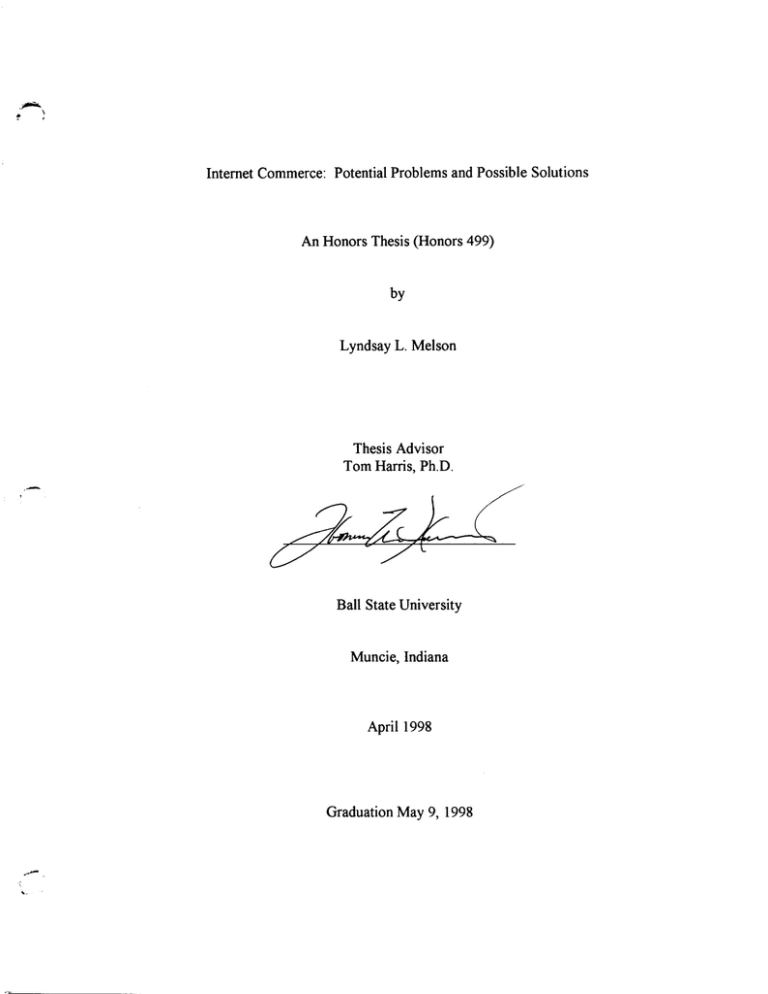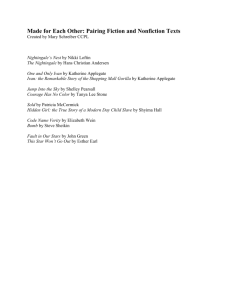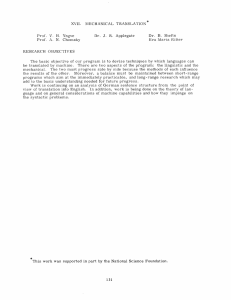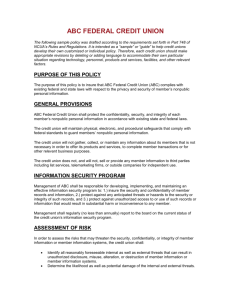L.
advertisement

Internet Commerce: Potential Problems and Possible Solutions An Honors Thesis (Honors 499) by Lyndsay L. Melson Thesis Advisor Tom Harris, Ph.D. Ball State University Muncie, Indiana April 1998 Graduation May 9, 1998 ..... ' -, I / '.1 , :) '17 i." (. / <" !.~' J .. ~) ' .. Purpose of Thesis This thesis is an examination of the impact the proliferation of Internet technology has had on the business world, more specifically on the role of a manager. The Internet has brought a new focus to business, however it has created many additional decisions and dilemmas for manager's today. There is an exploration of possible solutions for many potential problems, with suggestions for appropriate planning methods. The Internet has brought connectivity and cooperation to the forefront of managerial responsibilities, while increasing emphasis on the exploration of new technologies. - -, - Introduction The emergence of new technologies which allow for commerce to travel and take place electronically are changing the function of business. The most influential and potentially rewarding aspect of information technology is that of the Internet. The world has never before witnessed a technology developing as quickly as the Internet. Beyond development, the business world has not even begun to feel the full effect this technology will have in changing current practices. The functionality and popularity of the Internet has increased exponentially within the past two years. Five years ago no companies were even considering the Internet as a means of business transactions. By the time many managers first learned of the Internet, millions of dollars were already traveling through "cyberspace" (Applegate 1-4). Many managers were caught without preparation and a .- new generation of problems and decisions have arisen from the proliferation of the Internet. It is invading every function of business from finance, to marketing, to production in some form or another. The Internet is a technology that developed so quickly that many managers were caught off guard. Today, information technology (IT) managers are faced with new decisions and dilemmas concerning the Internet, which add complexity to the issues they face. The answers are not easily defined in black and white; in fact much of managing the Internet involves sorting through gray areas. IT Managers must recognize and act to solve the problems that Internet technology presents in order to insure the greatest value, and avoid disaster. This paper will examine the challenges of managing the Internet within an organization and suggest some possible solutions. - - Internet Background The focus on the Internet as a means of improving the function of business began with the evolution of the personal computer. As computers gained power, workers were amazed at the capabilities they now had at their fingertips. Thus the ability to network computers in order to facilitate the sharing of information became of extreme importance. As the Internet developed from its origination within the military services, a great potential for utilization in the business world was realized. According to Lynda Applegate, a professor at Harvard, and Janis Gogan, a professor at Bentley College, there are four key features of the Internet that contribute to its power as a source of electronic commerce. These four features are global connectivity, shared ownership, flexible information sharing, and low cost. The Internet first and foremost is a global connection, which allows for this .- one technology to reach more individuals and companies than any other technology. Secondly, the Internet is not owned by anyone person or company and therefore exists without regulation. Thirdly, the Internet platform is flexible and can encompass a wide variety of transmission media while also providing the necessary support tools. Finally the low cost feature of the Internet is a motivator for any company or individual. For approximately $20 per month or less added to the traditional cost of phone service, an organization can have unlimited access to the Internet (Applegate 2-4). According to Applegate and Gogan, three trends have contributed to the importance of a manager's awareness and decisiveness concerning Internet usage. These three trends begin with the emergence of mass customization within commodity markets - (Applegate 15). This is an increasing push toward lowering costs and improving service. Commodities are increasingly less differentiated which contributes to the need for 2 improving both profit margins and customer service (Applegate 8-9). The second trend is that of the rise of specialized experts who provide value chain integration (Applegate 15). This is evidenced through the drive toward an integrated supply and customer chain (Applegate 11-12). Such as Just-In-Time provided an on-line, integrated service to inventory management, the Internet can allow immediate communication and transactions with both suppliers and customers. The third trend is that of current power struggles that are causing new forms of channel management (Applegate 15). The Internet is eliminating the competitive advantage of organization's that had previously established themselves as the proprietary manager of distribution and supply channels. Competition among the channel "brokers" competing for the Internet market has allowed for quickly changing channels and costs associated with the value chain (Applegate 12-15). As managers prepare to face the challenges presented by the Internet in the work place, it is important to have a clear vision as to what is the ultimate goal of the organization concerning Internet usage (Applegate 4). For this purpose a fictional example of one company's Internet situation follows. The Ideal Visionaries predict the ideal work environment will depend on the rapid exchange of information from the desktop, in the pursuit of knowledge. Consider the following fictional example. Jane Smith sits at her desk at Carroll and Rowe (C&R), a large manufacturing firm and receives a call from her supervisor. They need research on a new product for a presentation tomorrow at 8:00am. Jane immediately clicks on the icon to access the web browser; she quickly enters the query information. Within a few seconds 3 Jane has 10 documents which support her query and the supervisor has his needed information within 30 minutes of his request. At the same time, John Jones in the Marketing department has just finished analyzing the figures for their on-line catalog service. Sales were tremendous and were taking place for less than half the cost of traditional sales methods. McNeil & Son, the company's primary customer, has realized a tremendous cost saving in completing the majority of its purchases on-line. Mr. McNeil, the CEO, looks over cost statistics for the quarter and is pleased with a significant decrease. Later that day, ABC Company, an important vendor calls the manufacturing department to ask that he be forwarded production statistics for the last quarter. Karen Olsen, the production manager, informs the vendor that all statistics are accessible via the web page and can be obtained with proper authorization. Karen calls the IT department and requests that ABC be assigned an identification number. The vendor is happy because this will save him time making phone calls and waiting for e-mail. Within the hour ABC has it identification number and is accessing necessary documents via the web. The entire organization is moving with greater productivity and information is provided with easy access. Knowledge is proliferating throughout the organization with great ease; the company is realizing larger profit margins and greater sales activity due to the ability of the work force to access the knowledge base provided by Internet technology. This is the ideal situation for Internet technology in the workplace. However, as many managers are discovering, the Internet is far from ideal, and they are responsible for solving these problems. 4 Strategy Issues Without an effective strategy C&R would not be able to realize the full potential of Internet technology. The Internet is a powerful tool for accessing information, yet like any tool, the user must understand how to use it correctly. The Internet can be a resource that is mostly helpful in wasting time, ifit is not effectively managed and understood. Jane Smith could easily spend 3-4 hours in her query for needed information. The strategy and education she received at C&R help Jane use the Internet as a tool, not a waste of time. Scholars often question the benefit the Internet has had on corporate business in terms of productivity and profitability. Economists and other management scholars contend that despite its proliferation, the Internet is not paying off in terms of productivity and real gains. However technological experts contend the benefit of networked computers in improving product quality, development, and customer service cannot be paralleled (Lohr D9). Thus the manager of information technology such as the Internet often finds him/herself in a position of justification. The manager can facilitate the task of managing the Internet if an effective strategy is in place to provide the desired outcome. Crafting an Internet strategy is the first step to managing its utilization within the organization. The traditional path of Internet technology in the organization begins with a public web site, which allows a business to extend its market reach. The motivation behind the move to Internet commerce is the possibility of increased sales, and increased profit from those sales. The cost of conducting business on the Internet is significantly lower than that of traditional methods of sales (Senne 26). One retailer found that the cost of sales on the web is 5 percent, while the nearest comparison cost of catalog sales is 22 percent. The 5 - bottom-line is the driving force in the information technology field behind the move to the Internet (Senne 26). An effective strategy must be in place before an organization is able to realize the potential. If John Jones is in a position of managing an on-line catalog, significant preparation is necessary. A coordination of manufacturing, marketing, finance, and shipping/receiving is necessary to ensure the on-line service will be beneficial. The next step for an IT manager is to move to utilizing Internet technology internally in an Intranet. For the purpose of simplification, many of the problems in managing the Internet are assumed to be interchangeable with that of the Intranet. The ultimate goal of Internet technology is to extend beyond both sales and processes to every aspect of the supply chain. Internet profitability can reach from beginning to end, and involve every aspect of ,- today's business environment. The Internet has brought awareness to the need for effective management of all information technologies in the workplace. Successes and failures are visible every day. One expert sees the key to effective management lies in the correct analysis of how the company is utilizing the technology, and what applications of the technology will affect the organization. The truth behind the Internet is that it is an enabling technology that can improve productivity, improve performance, connect companies to customers, and develop new business opportunity (Curry 74). Effective management and utilization of the technology are accomplishing all of the previous. A manager must now focus attention to ensuring that the Internet strategy will reflect the goals of the business as well as the most valuable returns that can be realized from the use of the Internet. This focus on the goals of the organization is essential. If John Jones is managing the on-line catalog services for a manufacturing facility whose primary goal is serving large organizations. An 6 - Internet strategy for selling to the general public does not follow the goal of the organization. This can cause confusion and a loss of focus for the company. The final measure of the effectiveness Internet strategy is to analyze the role of the Web in the organization. A successful strategy will allow for the "integration of the Web as an information, communications, and project-management tool across the organization," (Curry 78). The manager must be aware that as Internet technology becomes commonplace within the business function, it is more important for the strategy of the Internet to fulfil the needs of the organization. The potential is significant, but the secret lies within the proper planning, organizing, leading and controlling of the Internet within the workplace; the task of the Internet manager. Security Issues ,.- Easily the most prevalent and talked about issue facing managers of the Internet is that of security. In order for electronic commerce to continue its growth, the consumer must feel that the Internet is secure and safe. ABC Company will not want to transfer important financial documents to C&R if they feel that the transfer is not secure. Interference from other sources, whether intentional or not, are a primary concern for IT managers. This presents a unique dilemma to the managers because it is not easy to keep the bad people out, without keeping the good people out too. An essential issue to web management is figuring out how to do just that. According to John Wylder, a senior vice president for information technology (IT) at Sun Trust Service (Atlanta Bank), "the key is ... understanding what kind ofInternet use creates what kinds of threats and then matching products to those threats" (McCarthy 113). The issues dealing with web security are not new to the field, and have lead to many of the larger corporations forming 7 task forces and consortiums to investigate and solve the problem of Internet security. One such consortium, the Open User Recommended Solutions (OURS) has identified some of the basic threats to Web sites. These threats are as follows: data destruction, interference, modification/replacement, misrepresentation/false use of data, repudiation, inadvertent misuse, unauthorized altering/downloading, unauthorized transactions, and unauthorized disclosure (McCarthy 114). The most significant of these are data destruction, modification/replacement, misrepresentation/false use of data, and unauthorized disclosure. Threats to Internet sites ABC Company, excited with the new Web page information from C&R, begin to utilize this service daily. One of the employees of ABC begins to notice that historical - data is changing frequently. He calls Karen Olsen to inquire about the correct statistics; she feels that the information should not be changing. Upon investigation C&R finds that the integrity of their web site has been compromised and an outside individual is corrupting the company data. The company information is being tampered with causing data destruction and interference. Data destruction concerns the loss of data from a Web site, and interception of web traffic. This can be either intentional or unintentional, and can cause sales transactions, user information, or other important information to be lost forever. Modification/replacement, is the altering of data either coming or going, which change the information being processed. These can be hard to detect in large transmissions, and in areas of high traffic. The third major threat is that of misrepresentation/false use of data. This can range from incorrect passwords to false credentials, to counterfeit web pages. 8 The potential here is lost business, illegal information distribution and the threat of espionage. The final major threat is that of unauthorized disclosure. This is the viewing of web information by someone who has not been given permission for access. This is extremely problematic for companies who are placing the bulk of their business transactions on the Internet, and especially troublesome to banks and financial institutions (McCarthy 115). These are threats that no manager would like to see realized. A secure environment for web commerce is imperative. Thus managers are concerned with not only what threats exist, but also how to combat these threats effectively. Preventative Measures According to the OURS consortium, the most common and recognized form of web .- security is that of user identifications and passwords. It is recommended that all Web sites allowing update and write privileges utilize this form of security. It is relatively simple to implement and effective if managed well. Integrity control is the most common method of ensuring secure Internet and electronic commerce transactions. This utilizes data encryption and message authentication, which can ensure that someone unauthorized has not altered the message. This can also include firewall protection, which can allow only authorized users to enter into certain areas of data storage on the Internet. Another weapon against security threats concerns that of availability controls. This is essential to all web-oriented business and yet is often overlooked. The following table created by Linda Applegate and Janis Gogan illustrates some of the common concerns and solutions of Internet security discussed: 9 Problem Authorization Authentication Integrity Privacy ,- Fraud/Theft Sabotage Business Concern Does a user have permission to access a specific computer or collection of information? Is the user truly whom he/she purports to be? Did the person sending the message actually send it? Can the receiver be sure that the message has not been changed? Is my conversation (or business transaction) private? Is anyone eavesdropping or spying? Is anyone stealing from me? Can someone enter my system and destroy or alter information? Solution User name and password, or other kind of access control mechanisms. Special purpose hardware and software system generates random number which user then matches to authenticate identity. Digital Signature Public/private key encryption algorithms, Log, audit, systems management policies and procedures. Firewalls Firebreaks Applegate and C'JOgan, Harvard Busmess RevIew, 1996 page 17. The integrity of the Web site is essential. Can the data be accessed whenever necessary, can the web site handle the amount of traffic, what happens in the case of a failure? These questions plague the Web-site managers when dealing with availability. Like that of network management, fault tolerance, backup/recovery, and capacity management systems can all be helpful in ensuring data integrity on the Internet. Confidentiality is the last major concern for web managers. This is especially true in organizations that wish to publish mission-critical information on the Internet for easy access. One possibility is to provide end-to-end encryption that is shielded from the public 10 Internet and would virtually eliminate the threat of unwanted viewing and altering of the data (McCarthy 116). The security issues facing the managers ofInternet technology are complex, and often daunting. "Security decisions will only become tougher as companies continue to exploit the power of the Web" (McCarthy 117). The IT managers face not only increasing security issues, but many additional concerns as well. While security is often top priority, Internet management is an area of study that is easy to underestimate. C&R found that although they had installed password protection to their web site, the protection was not enough. In an effort to correct the problem with data integrity, they installed new firewall and data encryption software. By taking steps to insure the integrity of the information the company is posting on the Internet, C&R has prevented the potential for loss of business. ABC Company is reassured that the data is secure and once again is able to access necessary statistics from C&R via the Internet. Accessibility Issues Organizations must consider how they can allow and increase public access to their Internet Voleb-sites while also promoting proper use of the Internet. The vast storage of information within the Internet makes navigation both time consuming and difficult. It is essential for an information technology manager to ensure that data is organized in both an effective and efficient manner. The organization should "ensure that any material they place on the Internet can be readily located by the intended users and is coherently and logically structured in a user-friendly format" (Issues 3). The Internet itself is userfriendly, and yet sometimes can be a hindrance when looking for specific information. A manager must not only be aware of accessibility problems, but also try to ensure that the Internet content of the organization is well maintained. 11 - C&R implemented accessibility standards throughout the organization in an effort to eliminate redundancy and confusion of information. Web pages were evaluated before being placed on the web site and all web sites must fulfill company guidelines. This is in an attempt to establish consistency with the company Web site, which allows for ease of use. Legal Liability In addition to security issues, IT managers face the legal liability that the Internet has generated. According to an article in Risk Management magazine, there are three major areas of potential liability for companies utilizing Internet technology as a means of commerce. The first of these is that ofliability exposures. This is the use of unlicensed -- content, logos, registered trademarks, or homepage design and also hyperlinks that give the appearance of affiliation, infringement, or defamation. The risks are great to an organization that may not realize the public has posted information that may leave them legally liable. The second area of concern is that of the aforementioned security risks. The final area of concern is that of first-party risks associated with Internet management. This is the organization's own responsibility to guard against content that could lead to harassment claims, credit card fraud, and security breaches. These first-party risks are the leading factors to effective web content management within the organization. Internal policies and procedures must be in place to set guidelines for appropriate and responsible material that is posted within the company's Web-sites (Pelland 8). Copyright and intellectual property rights are a major concern for an organization dealing with the Internet. Laws governing copyrights and intellectual property protect ,-, information posted on the Internet. The ease of obtaining such information sometimes 12 leads to the user forgetting that this is essential to remaining free oflegalliability. Most information is available for use by the public, but not for sale. It is also a problem when employees receive or download shareware or other illegal software from the Internet. The organization is liable for any information obtained without proper authorization (Grimsley F1). Carroll and Rowe felt the company was not under threat of legal liability due to Internet usage. Yet an audit conducted of software installations on personal computers throughout the organization found nearly 50 percent of their employees had illegally installed software. This is an enormous problem for C&R due to the copyright laws that had been violated. Yet, the Information Technology department was puzzled by how they - . could curb the abuse of the Internet while still allowing access to their employees . Internal policies and guidelines can lead to more controversial issues within the workplace. The Internet is being utilized within the workplace with increasing frequency. The projected growth of the Internet in the workplace is expected to reach 70 percent by the years end of 1997 (Wall Street A: 1) This exponential growth is leading to a controversial debate among IT managers; How much should the Internet be monitored and controlled by the corporation? The Internet itself is an unregulated bastion for the first amendment right of free speech and press. Government attempts to regulate the Internet have been met by strong opposition. Thus it is left to the corporate managers and executives to determine how much control is enough. Controlling and monitoring Control is by far the largest issue facing Internet managers today. At Carroll and Rowe, results of the audit that found illegal software, spawned a debate on how the 13 - managers should control and monitor Internet usage. This is a familiar theme in the corporate world today. Karen Olsen feels that the audit of personal computer content was a violation of her privacy. John Jones feels that all Internet activity should be logged, and abuse of Internet privileges should result in termination of employment. Jane Smith feels the internal audit was necessary, but is offended by monitoring of electronic mail sent via the company's Internet access. Often employees of the same organization have very different viewpoints as to the need for monitoring of Internet access, thus posing a dilemma for managers. A debate has arisen among the decision-makers within every organization involved in Internet usage in the workplace. This debate concerns whether or not a manager, ofIT or otherwise, should be monitoring their employees use of the Internet in the workplace. The Internet is designed to be a tool in facilitating access to information, suppliers, distributors, marketing, and virtually every function of business. The problem facing the manager today is how to utilize the technology to its fullest potential, while curbing the misuse of the Internet in the workplace. A recent study of 906 large corporations by the American Management Association, found that 35% were keeping watch of their workers by various means. These means range from taping phone calls, taping voice mail, storing and reviewing computer files and e-mail messages, to even videotaping employee performance (Grimsley FI). Justification given by these organizations is most likely the fact that improper use of such devices is inappropriate and a reason for investigation. Many companies are using this surveillance to control unauthorized use of equipment, "using company telephones to make long-distance phone calls, or scrolling the Internet for recreational purposes," which they deem unacceptable (Grimsley F 1) . Yet the very nature 14 of the Internet makes it impossible to conduct relevant scrolling one hundred percent of the time. Any user of a Web Browser is painfully aware that searching for information can sometimes be a daunting task filled with hours of useless searching before obtaining the desired information. In general most companies deny using these surveillance techniques with the strict intent to catch people in the act, but rather to limit the desire to abuse company time. Some employers have monitored employees use of electronic equipment and job performance for many years, and have not received any negative feedback from such acts. AT&T has been recognized for its superior customer service, which executives credit largely to surveillance of their customer service agents to insure quality of service (Grimsley F2). Not only do managers have to make decisions on what amount of monitoring is appropriate, any amount at all receives negative responses from both employees, and more recently the American Civil Liberties Union (ACLU). The ACLU contends that this surveillance is an invasion of the employees right to privacy that extends within the workplace. The ACLU is also concerned with the ethical responsibility the corporations have to their employees, in which monitoring their actions for the sake of productivity is deemed unacceptable by the members of the ACLU (Grimsley F2). Managers may see the need for security and emphasis on employee performance, but the question still remains; How much is too much? Inappropriate Content and Usage Specific to the Internet, managers are faced with issues that deal with inappropriate content and usage of the technology in the workplace. An attorney with the - Electronic Privacy Information Center, says that "employers are cracking down on how employees use the Web, primarily because they believe employees are not being 15 productive enough," (Dutt Gl). The attorney also believes that a good company would not resort to sneaky surveillance because a good company should be able to trust its employees. One analysis by Neilsen Media Research found that employees at IBM, Apple Computer, and AT&T "together visited Penthouse magazine's Web-site 12,823 times in a single month," (Rigdon B 1). These statistics are staggering, thus it is easy to see why companies are seeking ways to monitor and control this technology. Experts believe that the focus of the company is not simply productivity, but is the possibility of an infringement upon the integrity of the organization. The same technology that leads to freedom and collaboration can also lead to disturbing leaks and breaches of employer trust. Electronic mail, too, presents an even bigger problem to managers of the Internet. Abuse of mail sent with company identification can lead to legal and ethical abuses . - . Company documents can be lost, mailed to unauthorized persons, or even misused by noncompany personnel. These types of infringements are hard to detect and require many hours of damage control when such an occurrence does take place (Rigdon B8) Efforts to block employees from Internet sites that deal with pornography, hate organizations, and so on, may even lead the company into a greater legal liability. One Internet Law expert said corporate site blocking could lead to disaster. "If a company blocks access to pornographic sites, but not to sites where illegal software can be downloaded, they could be even more likely to be liable for that even if it were done inadvertently because they had started down the blocking path," (Dutt G7). This is an area of concern for businesses and managers. The legality of such issues is a problem, but it is not foreseeable that companies will abandon attempts to block employees from spending company time on recreational use of the Internet. 16 In addition to concerns about the employees' use of the Internet in the workplace, managers must be aware of the responsibility of the material published by employees on the web to the organization. Often companies develop Internet/Intranets, which allow employees to design and develop their own web-sites, as well as include their own information. An extremely important task of the IT manager is to develop a plan that will allow the employees freedom of spirit, while ensuring the standards that reflect the proper corporate image. The IT department and manager cannot be taxed with the responsibility of developing all information for exposure on the web, so companies are exploring additional avenues. Many managers have found that Front-page technologies can be customized to allow users to implement their own information within a set limit or guideline. "The strategy allows central control of design and search engines, but leaves content as a local issue," (Talmor 73). Thus managers can establish the necessary controls without eliminating the employees sense of freedom and entrepreneurship. On-line Communities The Internet is still considered to be in its infancy, but since hoards of users have overtaken the net it has remained essentially lawless. The IT manager is faced with the immediate challenge of establishing rules for governing the Internet within their organization. In an effort to expand their capacity for maintaining a secure environment many businesses are moving toward on-line communities where rules are established to allow commerce to proceed (Spar 126). An Internet manager will need to explore the adoption of the on-line community for the establishment of a secure environment, especially for the purpose of on-line sales (Spar 126-133). 17 - In the example John Jones is pleased with the results of their on-line catalog service, however the success of this service is entirely dependent upon security and integrity. One possibility for Carroll and Rowe is to establish its presence within an online community with its suppliers and customers. This is the type of community where C&R, McNeil & Son, ABC Company, and the entire commercial chain could co-exist to facilitate the transfer of knowledge. Education Issues An often overlooked, but extremely essential task that falls under the IT manager is that of employee education. Technical managers have a tendency to overestimate the knowledge level of the employees within the organization. Often the Internet is put into place with little thought toward the need for proper education. An Interview with the Director of Education at Saint John's Health System in Anderson, Indiana produced some interesting insight into one view of the importance of education. Upon the commitment of the Information Resources (IR) department to installing Internet capabilities throughout the organization, no thought was given to educating the users as to the Internet. The IR department assumed that the Internet had reached a point of existence outside the office that everyone in the organization had some pre-existing knowledge. This assumption proved incorrect. The users (mainly nurses and professionals) were not, in fact, Internet literate. Thus, the implementation of this new technology proved ineffective (Melson). In order for the Internet to effectively work for a positive means in any organization, there must be education. According to Mary Cronin, a professor at Boston College, close coordination is the key to effective Internet management. A resistance to the changing work environment, confusion, and overwhelming feelings of uncertainty are 18 - often the case with employees who have first been exposed to the Internet. Cronin says, "Companies must make a plan for training people throughout the organization" (74). The use of the Internet within an organization must be all inclusive, divisional use cannot be effectively supported. Cronin suggests that an Internet Planning Committee be formed from the beginning of the education process. This committee is to be structured in a way to have functional support and ideas from throughout the organization to create a cooperative environment for sharing information. Cronin suggests the committee be comprised not only ofInternet supporters, but also of "people who need to be convinced that the Internet can help them ... " (78). This strategy is in order to educate all employees, whether or not the territory is unfamiliar. An up-front approach to the proliferation of the - Internet in the workplace can facilitate the transition and ease a manager's burden. With policies and procedures to support the implementation of the Internet, managers have resources established to which they may address concerns, and solve problems. The Reality The implementation of Internet technology has the potential to meet the vision of companies like that of Carroll and Rowe. The challenge is for IT managers to adapt their Internet strategy to fit the organization. Whether planning to utilize the Internet companywide or in a few processes, problems are prevalent. As is apparent with all of the possibilities presented by the Internet, it is important to understand the need for planning, coordinating, leading and controlling this technology. These functions of management are further complicated by the difficult nature of the Internet. There is a potential for an amazing resource of information, knowledge, commerce, and productivity within the Internet. However, this potential is not fully developed and is often a daunting aspect of 19 information management. The complexities of the issues lead to frustration as well as triumph. For an organization or manager who is faced with the task of developing the Internet, it is imperative that they design their strategy and rules to fit the needs of the organization. Learning to manage and harness the power of the Internet is a dangerous game. As the Internet proliferates, so does the risk associated with utilizing the Internet in business. As people become interconnected and transactions take place within split seconds, managing the tool that provides this service is essential. As a tool, the Internet is only as good as its weakest manager. Thus a poorly planned implementation and use of the Internet can negate its value almost completely. The Internet is quickly becoming an expectation of business transactions. An Internet manager is best utilized when realizing the power of the technology, but also recognizing and planning for its potential difficulties. 20 Works Cited Applegate, Lynda M. and Janis Gogan, "Paving the Information Superhighway" Harvard Business Review. July 22, 1996, pg 1-25. Curry, Sheree R. "Getting your company's Internet strategy right." Fortune. March 18, 1996, pg 72-76. Deering, Ann M. "Are you exposed on the Internet?" Risk Management. April 1996, pg 18. Dutt, Jill. "Smith Barney Explores Blocking Sex Sites on Web." Washington Post. January 17, 1997, pg GI. Grimsley, Kirstin Downey. "35% of Firms Found to Monitor Workers Electronically." The Washington Post. May 24, 1997, pg FI-F2. "Issues Related to the Use of the Internet." Internet. http://www.open.gove.uklcetalinternet/issues.htm. March 1, 1998. - Landog, Scott. "Should IT be employees Web Nanny?" PC Week. December 15, 1997, pg90 . . Lohr, Steve. "Scholars Debate Internet's Productivity." The New York Times. April 26, 1997, pg D9. McCarthy, Vance. "Web Security: how much is enoughT Datamation. January 1997, pg 112-117. Melson, Patricia. Interview. Saint John's Health System. February 1998. Pelland, Dave. "Keeping your site safe." Risk Management. June 1997, pg 8. Rigdon, Joan Indiana. "Curbing Digital Dillydallying on the Job." The Wall Street Journal. November 25, 1996, pg B 1. Senne, Jeff. "Action Strategies for Using Net Technology." Women in Business. September/October 1997, pg 26-28. Spar, Debora and Jeffrey 1. Bussgang. "Ruling the Net" Harvard Business Review. May/June 1996, pg 125-133. Talmor, Sharona. "When IT comes together." The Banker. March 1997, pg 73-75. "Work Week." The Wall Street Journal. February 18, 1997, pg AI. 21







